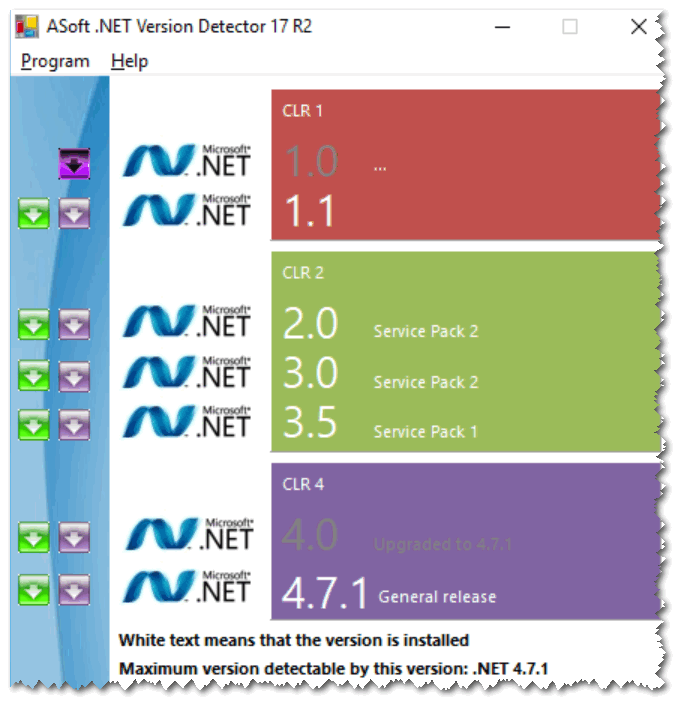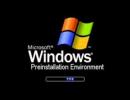What is Microsoft.NET Framework. How to install and reinstall NET Framework? Microsoft.NET Framework: why it is needed and how to install it on Windows Installing microsoft net framework 4
For those who have at least the slightest understanding of computer software, it is absolutely clear that in any case there comes a time when the need arises to install NET.Framework.
Users often have problems installing and using NET.Framework
This is not surprising at all, since NET.Framework is a platform on which you can create and then subsequently run some applications. Since Microsoft is the developer of such a platform, it is, of course, designed for Windows, although it is still possible to install NET.Framework on some other operating systems, including Linux.
Unfortunately, the installation of the platform is not always successful; users have to face serious problems when system errors occur, due to which the installation process ends in sudden failure.
Of course, the question immediately arises as to why Microsoft NET Framework 4 is not installed. Having received the answer to this question, you can find ways to fix the problem.
Inexperienced users, having heard about possible errors that occur during the installation of NET.Framework, want to know whether it is possible to do without installing such a package on the computer. In principle, there is no need to immediately overload the operating system with all sorts of additional applications and programs if the user does not need them. Programmers recommend installing only software that the user directly needs. Excessive loading of the OS with unnecessary programs provokes a shortage of free space on the hard drive, which worsens both the operation of the system and its performance.

By the way, Microsoft initially included the NET.Framework download in the Windows 7 installation package. In addition, the platform can also be loaded automatically if the user wants to install some gaming applications, since in this case, game developers foresee that the game will not launch without such a platform. In order not to bother the user with additional searches, the installation of the platform is immediately included in the game’s boot file.
Common errors
Having understood the algorithm for installing new software, users, by analogy, proceed to install NET.Framework on Windows 7. By consistently performing all the proposed actions, the user reassures himself that everything will go absolutely smoothly, and soon the platform will be successfully installed on Windows 7, after which he can immediately begin downloading and then launching your favorite game.
However, in some cases, disappointment arises because you have to deal with the fact that even if you strictly follow the instructions, NET Framework 4 Windows 7 still does not install, displaying a “sad” message on the screen.
The most common cause is a conflict situation that occurs in Windows 7.
Microsoft has confirmed that the problem that prevents NO Framework 4 from installing in Windows 7 is indeed related to Windows Update.
Of course, if a problem arises, it means that there is someone who is trying to find ways to solve it. So in this case, programmers have already found effective ways to circumvent the error that occurs by successfully installing NET.Framework on Windows 7.
In this case, there is no need to do something incredible; the algorithm for eliminating the problem is described in detail, so even those who do not have sufficient practical experience can master it.
How to install NET.Framework
“I can’t install the NET Framework” is a phrase that many users hear. The combination “I can’t” simply filled thematic forums. Fortunately, there are programmers who, thanks to their excellent knowledge and practical skills, are able to find various options for eliminating errors. In addition, they do not hide their ingenious “finds”, but are happy to share with everyone, so on the forums you can often find valuable advice that allows even absolute “dummies” to solve problems.
Algorithm of actions focused on installing the platform
To install NET.Framework on Windows 7, you must first remove previous installation traces of all versions. It is quite difficult for inexperienced users to perform such manipulations, since Microsoft has quite tightly intertwined the system folders with the platform folders. For this reason, the previous version may be very difficult to remove, or, in general, there is no way to “get rid” of it.
This step cannot be ignored either, since during a new installation of the platform on Windows 7, an error may occur again.
In order for the entire process of uninstallation and subsequent installation to be successful, it is important to follow all the recommendations of experienced users. First of all, it is recommended to download the dotnetfx_cleanup_tool.zip file. Next, it should be opened and then immediately removed, since it is archived.

In the folder in which all the extracted files are located, you need to find the cleanup_tool file with the exe extension. This is what should be launched. A new window will immediately appear asking permission for all subsequent actions. By clicking on the “Yes” button, the user agrees with everything, so the program continues to perform all other actions.
At some point, a window will appear asking you to select the Microsoft product you want to remove. Among the proposed list there is the line “NET.Framework - all versions”; after selecting it, all you have to do is click on the “Clear” button.
However, such an application is not omnipotent, since it will not be able to remove NET.Framework 2.0, since this version of the platform is defined by Microsoft developers as an integral part of the operating system.
After cleaning is completed, the computer must be restarted. Microsoft developers make such requirements for many important procedures associated with the installation and uninstallation processes.
After starting the operating system, you should install several versions of Microsoft.NET.Framework sequentially. Initially, version 1.1, then proceed to install versions 3.5 and 3.0, then you will again need to restart the computer.
Finally, all that remains is to enable Windows Update and after that safely install Microsoft.NET.Framework 4.
Despite the fact that you will have to spend some time performing all the indicated actions, the user can definitely be proud of the result obtained. New knowledge, supported by practical skills, is always considered as a “golden treasure” that can be useful many more times.
So, every user can install the NET.Framework 4 platform on a computer, despite some difficulties, if they believe in their own abilities and follow the recommendations of experienced users.
NET Framework (Dot Net Framework) is a software platform (software framework) developed by Microsoft Corporation in 2002, mainly for the Microsoft Windows operating system. Includes extensive libraries, and also provides cross-compatibility (each language can use code written in other languages) of several programming languages. Programs written in the .NET Framework run in a software environment (as opposed to a hardware environment) known as the Common Language Runtime (CLR), which is a virtual machine that provides security, memory allocation, and exception handling. The class library and CLR together make up the .NET Framework.
The core .NET Framework class library provides access to the user interface, data communications, database connectivity, cryptography, web application development, computational algorithms, and network connections. Programmers create their applications by linking their own code with the .NET Framework libraries as well as other libraries. The .NET Framework is intended to be used by most new applications being developed.
ATTENTION: Be sure to install the update packages in the same order in which the links to them are given!
.NET Framework 1.1
.NET Framework 3.5 SP1 (includes 2.0 SP2)
Updates:
Windows XP/Server 2003 32-bit:Update 1 (8.6 MiB)
Update 2 (7 MiB)
Update 3 (1.4 MiB)
Windows XP/Server 2003 64-bit:
Update 1
(18.4 MiB)
Update 2
(16.5 MiB)
Update 3
(1.5 MiB)
Windows Vista/Server 2008 x86:
Update 1
(1.4 MiB)
Update 2
(10.5 MiB)
Update 3
(6.9 MiB)
Windows Vista/Server 2008 64-bit:
Update 1
(1.5 MiB)
The Microsoft .NET Framework is the common language runtime (CLR) and associated files required to run applications developed for the .NET Framework.
The Microsoft .NET Framework is a new managed code programming model for the Windows operating system.
As soon as you install the .NET Framework, the component will instantly create all the necessary conditions for the program to work. Thus, this component creates the necessary conditions for the operation of your programs.
The .NET Framework can be installed on Windows NT, 98, Me, 2000, XP, Server 2003, Vista, Server 2008 and 7, 8 operating systems.
I would say that the .NET Framework is not codecs, but an alternative to java - a virtual machine capable of executing code written for it on different platforms.
Unlike Java, the code can not only be interpreted by a virtual machine, but also translated for execution directly on hardware (this gives higher performance).
Its use is not limited only to the Internet; regular software is also written for .NET. The advantage of this software is that it will run on any computer and on any operating system with .NET support, for example on cell phones.
The .NET Framework has been bundled with Windows for a long time. Windows 7 comes with version 3.5 and some previous versions for compatibility. Currently version 4 is current.
Unlike Windows 7, 8 comes with platform version 4.5, which is installed automatically during installation of the operating system. Therefore, if you have the Windows 8 operating system installed, then you do not need to download any installers, everything is already installed. Read more about the platform on the MSDN website.
How to determine which version of .NetFramework is installed?
There are 3 simple methods for determining the version of the .NET Framework installed on your computer:
Method 1:
Using Windows Explorer
Using Registry Editor
Using a small portable utility.NET Version Detector All versions of the Microsoft .NET Framework are installed in the following folder:
Where " %windir%" - the root folder in which "Windows" was installed, i.e. C:\Windows\.
Go to the menu Start->Run and then enter the command %windir%\Microsoft.NET\Framework\ This command can also be entered into the address bar of Windows Explorer (i.e. any folder). A folder will open, it is shown in the following screenshot:

In this folder you can see which versions you have installed.
Method 2: Using the Registry Editor.
You can also find out which version of the .NET Framework is installed on your computer through the Registry Editor:
- Go to the menu Start->Run and then enter the command regedit and press Enter.
A window will open. - Now we are looking for the following key:
HKEY_LOCAL_MACHINE\SOFTWARE\Microsoft\NET Framework Setup\NDP - This key contains several more sections, each of which displays the name and version of the .NET Framework installed on your system.

Method 3:
Checking for installed versions of the .NET Framework is very easy using the .NET Version Detector

List of all versions of Microsoft .NET Framework
Below is a list of all currently released versions of the .NET Framework:- .NET Framework 1.0
- .NET Framework 1.1 (included with the operating system starting with Windows Server 2003)
- .NET Framework 2.0
- .NET Framework 3.0 (included with the operating system starting with Windows Vista and Server 2008)
- .NET Framework 3.5 (included with the operating system starting with Windows 7 and Server 2008 R2)
- .NET Framework 4.0
Download Microsoft .NET Framework 1.0
Download Microsoft .NET Framework 1.1
Download Microsoft .NET Framework 2.0
(web installer) (requires internet connection during installation)
Microsoft .NET Framework 3.5 Service Pack 1 (Fully Offline Installer)
Download Microsoft .NET Framework 4.0
Download (web installer) (internet connection required during installation) (Russian)
Good day.
It is not so rare to encounter various errors associated with the Microsoft .NET Framework package (most often in games, various editors, drawing programs, take at least the same AutoCAD...).
In all such problems, you need to find out which version of the .NET Framework the application requires, see if it is in Windows, and, if not, update/install it. It would seem nothing complicated, but there are nuances. They will be discussed in the article...
For reference. In general, the .NET Framework is a special package that is designed to combine various software written in different programming languages (so that everything works). In theory, you can compare it with codecs. Naturally, if you do not have the required version on your computer (or it has been damaged), then the program will not start for you.
And now, closer to the point, I’ll look at the most important thing...
How can I find out which versions of the .NET Framework I have installed?
Method No. 1
You need to open the Windows Control Panel using the following path: (approx. : Installation and removal of programms).

Important!
I note that in Windows 8 and 10, Microsoft .NET is not listed in the list of installed programs (to view versions, you need to open the link in the left menu “View installed updates”).
In Windows 10, it is not possible to remove .NET using standard means, however, as a rule, it is possible to install the latest version of .NET (updating it).

Method No. 2
To view and solve problems with .NET there is a special utility ".NET Version Detector" (available at the link:).
It does not require installation. After launch, it will show a list of all installed versions, and will also lead links to download them (if suddenly something is missing, you can download and install it).

Is it possible not to update this package, since I haven’t updated it before and everything worked?
Most users don’t even remember about it (for the time being...). The fact is that new versions of Windows already have a certain version of .NET included (pre-installed in the system) and there is no need to download or update anything separately.
In addition, .NET is often included in the installers of popular games, and when they are installed, this package is also updated. Those. all actions are invisible to the user...
However, it may happen that a new program or game requires a new .NET package (or, conversely, you want to run something old that requires a certain version of .NET and no other).
And then everything is simple: if the required version of .NET is not available, then upon startup you will see an error (as in the example below). By the way, some errors may be associated with a “broken” version of .NET (which is why it is sometimes recommended to update this software).

Firstly, I would like to immediately advise you: you do not need to download all the versions in a row and try to reinstall each one (a little lower I will note which versions are recommended for different OSes). Secondly, it is recommended to download .NET only from the official Microsoft website (unmodified installer, so to speak).
Method No. 1. A little higher in the article, I recommended that you use the ".NET Version Detector" utility - it will not only show which versions of the .NET package you have installed on your system, but also provide links to download each version.
- (for Windows XP);
- (includes .NET 2.0, 3.0; for Windows XP, Vista);
- (for Windows XP, Vista and 7);
- (for Windows 7, 8 and 8.1);
- (for Windows 7, 8, 8.1 and 10);
- (for Windows 7, 8, 8.1 and 10).
It is important to note that version .NET 4 (let's say) updates the previous version of .NET, so new Windows 8, 10 OSes require installing (in 99.9% of cases) only the latest versions of .NET 4.
Addition!
I can’t help but recommend the program - even if you don’t need to update drivers, try using it anyway. The fact is that it automatically detects missing components in the system that may affect games (.NET, Visual C++ and other packages), and installs them. Agree, it’s convenient!

Please note that the program downloads and installs everything necessary for games (.NET, Visual C++ and other packages) automatically!
Is it possible to remove the .NET Framework (or use a different version)? What does that require?
In most cases, you do not need to remove the package - you just need to use a different version. You can do this in the tab (which can be opened in the Windows Control Panel - just above the article shows where to find this) .
Actually, you need to put a checkmark next to the package that you want to use and agree to the changes (Windows may need to download missing files - it does this itself in auto mode (just need an internet connection)).

In cases where you seem to have the required version of .NET installed, but the game (program) still throws errors and “swears”, you can try to remove the .NET package and install it again.
In some cases, a package can be removed by opening the list of installed programs ( Control Panel\Programs\Programs and Features ). Uninstallation occurs in the same way as any other program (see screenshot below).

In some cases, a special utility may be required: NET Framework Cleanup Tool (link to Microsoft developer blog - ).
The utility does not require installation. By the way, you need to run it as an administrator (approx. : i.e. right-click on the executable file and select “run as administrator” from the context menu) .

That's all for today.
Additions are welcome...
All the best to everyone.
To put it in very simple terms, the .Net Framework is what allows most programs to work on . when creating them, the tools of this framework are used.
Those who are fond of games have already encountered DirectX more than once: almost every game requires its installation, otherwise it simply refuses to launch. Also here: a framework is akin to a skeleton on which a program is assembled. Without such a foundation, the entire structure is ineffective.
Activation of the preinstalled version
With Windows 7, Microsoft began pre-installing the framework; Thus, on any computer with “Seven” or a newer OS, this tool already exists. This move allows you to avoid wasting time on searching and manual installation.1. Open Control Panel → Programs and Features → Turn features on or off:
2. The list will contain Microsoft .NET Framework version 3.5. If for some reason there is no checkmark next to it, check it and click OK.

The program needs a newer version of the framework, what should I do?
It is important to understand that newer version.NETFramework does not always replace the old one. Those. if, for example, you have 4.5 installed, but not 3.5, and the program needs the old one, then it still won’t start. For compatibility with the maximum number of programs, install all available versions of the framework.Version 3.5 SP1 includes 2.0 and 3.0, so it’s better to install it right away.
Version 4.5.x includes 4.0, so it's okay if the "four" is missing. The exception is Windows XP; This OS version does not support 4.5, its limit is 4.0.
The problem is that you cannot install an older version over a newer one. But there is a simple solution.
- Run it and see which versions you need to install (those you have are highlighted in white, those that are missing are gray).

Removing .Net Framework
- Unzip the downloaded program and run it.
- In the window that opens, select what you want to delete. In our example - 4.5. The process can take up to 20 minutes, so if it seems to you that the program is frozen and nothing is happening, wait.
- After this, return to Version Detector and click “Refresh”.
- If everything is done correctly, the deleted version will turn gray.

Correct installation of missed releases
- Now in Version Detector, click on the green arrow next to the release of Microsoft .NET Framework that you want to install.
- You will be taken to the official Microsoft website, where you will be asked to select the installation language and download the archive with the desired version.
- The installation is quick; when finished, restart your computer.
- Do similar actions for all remaining versions, moving from older to newer.
The correct order of installing packages will help solve problems with many programs not working. However, Windows XP has a limit: higher than version 4.0 of the .NET Framework is not supported in this OS. If you encounter such a situation, all you have to do is either look for an alternative program or upgrade to a newer version of Windows.





